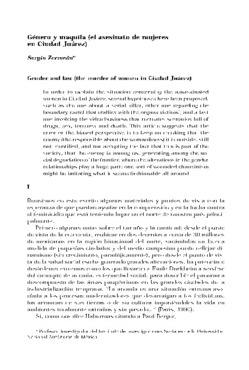Mostrar el registro sencillo del ítem
Género y maquila (el asesinato de mujeres en Ciudad Juárez)
Gender and law (the murder of women in Ciudad Juárez)
| dc.creator | Zermeño, Sergio | |
| dc.date.accessioned | 2019-07-01T17:48:45Z | |
| dc.date.available | 2019-07-01T17:48:45Z | |
| dc.date.issued | 2004-12 | |
| dc.identifier.citation | Zermeño, S. (2004). Género y maquila (el asesinato de mujeres en Ciudad Juárez). Revista de ciencias sociales, (15), 29-39. | es |
| dc.identifier.issn | 0328-2643 (impresa) | es |
| dc.identifier.issn | 2347-1050 (en línea) | es |
| dc.identifier.uri | http://ridaa.unq.edu.ar/handle/20.500.11807/1317 | |
| dc.description | Fil: Zermeño, Sergio. Universidad Nacional Autónoma de México. Instituto de Investigaciones Sociales; México. | |
| dc.description.abstract | Para explicar el drama de las mujeres asesinadas en Ciudad Juárez se han sugerido las hipótesis del “asesino serial” (serial killer), del cartel fronterizo que trafica con los órganos de las víctimas, del negocio de videos que recrean escenarios de drogas, sexo, tortura y muerte. Lo que se sugiere en este artículo es que el error o el ángulo viciado es seguir pensando que el enemigo (el responsable de este feminicidio) está afuera, aún no identificado, y no aceptar que es parte de la sociedad, está entre nosotros, se genera en medio de la degradación social de la frontera y de la maquila, en donde las alteraciones en las relaciones de género juegan un papel fundamental: una especie de machismo ultrajado estaría “copiando” lo que parece una “moda” a su alrededor. | es |
| dc.description.abstract | In order to explain the situation concerning the assassinated women in Ciudad Juárez, several hypotheses have been proposed, such as the one about a serial killer, other one regarding the boundary cartel that traffics with the organs victims’, and a last one involving the video business that recreates scenarios full of drugs, sex, tortures and death. This article suggests that the error or the biased perspective is to keep on thinking that the enemy (the responsible about the womanliness) it is outside, still not identified, and not accepting the fact that this is part of the society, that the enemy is among us, generating among the social degradation of the frontier, where the alterations in the gender relationships play a huge part: one sort of wounded chauvinism might be imitating what it seems fashionable all around. | es |
| dc.format | application/pdf | es |
| dc.language | spa | es |
| dc.publisher | Universidad Nacional de Quilmes | es |
| dc.rights | https://creativecommons.org/licenses/by-nc-nd/2.5/ar/ | es |
| dc.source | Revista de Ciencias Sociales | es |
| dc.subject | Mujeres | es |
| dc.subject | Asesinato | es |
| dc.subject | Problemas sociales | es |
| dc.subject | Mercado de trabajo | es |
| dc.subject | Globalización | es |
| dc.subject | México | es |
| dc.subject | Women | es |
| dc.subject | Assassination | es |
| dc.subject | Social problems | es |
| dc.subject | Labour market | es |
| dc.subject | Globalization | es |
| dc.subject | Mexico | es |
| dc.subject | Mulheres | es |
| dc.subject | Assassinio | es |
| dc.subject | Problemas sociais | es |
| dc.subject | Mercado do trabalho | es |
| dc.subject | Globalização | es |
| dc.title | Género y maquila (el asesinato de mujeres en Ciudad Juárez) | es |
| dc.title | Gender and law (the murder of women in Ciudad Juárez) | es |
| dc.type | info:ar-repo/semantics/artículo | es |
| unq.blm.ubicacion | P-AR-REV1 | es |
| unq.articulos.paginicio | 29 | es |
| unq.articulos.pagfinal | 39 | es |
| unq.revista.numero | 15 | es |
| unq.version | info:eu-repo/semantics/publishedVersion | es |
| unq.articulos.seccion | Artículos | es |
| unq.tipo.snrd | info:eu-repo/semantics/article | es |
| unq.acceso | info:eu-repo/semantics/openAccess | es |
Ficheros en el ítem
Este ítem aparece en la(s) siguiente(s) colección(ones)
-
No. 15
Publicada en octubre de 2004.

